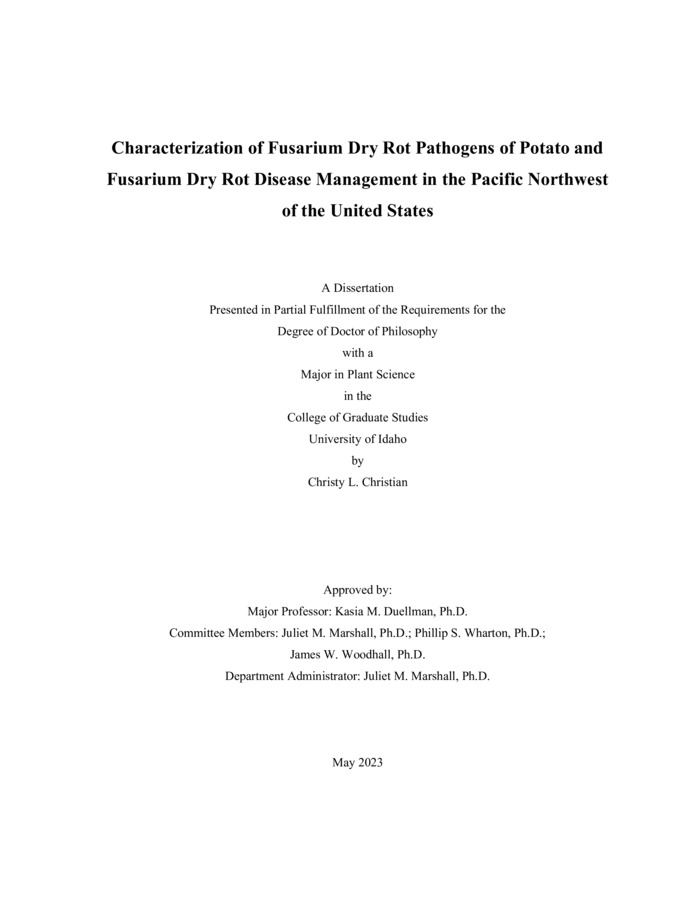Characterization of Fusarium Dry Rot Pathogens of Potato and Fusarium Dry Rot Disease Management in the Pacific Northwest of the United States
Christian, Christy L.. (2023-05). Characterization of Fusarium Dry Rot Pathogens of Potato and Fusarium Dry Rot Disease Management in the Pacific Northwest of the United States. Theses and Dissertations Collection, University of Idaho Library Digital Collections. https://www.lib.uidaho.edu/digital/etd/items/christian_idaho_0089e_12476.html
- Title:
- Characterization of Fusarium Dry Rot Pathogens of Potato and Fusarium Dry Rot Disease Management in the Pacific Northwest of the United States
- Author:
- Christian, Christy L.
- Date:
- 2023-05
- Keywords:
- dry rot fungicide Fusarium Fusarium sambucinum Pacific Northwest potato
- Program:
- Plant Sciences
- Subject Category:
- Plant pathology; Plant sciences; Agriculture
- Abstract:
-
Fusarium dry rot is a worldwide fungal disease of potato causing seed decay at planting and postharvest tuber decay in storage with lesions appearing as sunken, wrinkled, darkened areas on the periderm and dry, crumbly decayed tissue internally. With average yield losses of 6 to 25%, Fusarium dry rot is one of the most important postharvest potato diseases worldwide. The disease is managed through cultural practices such as wound management and crop rotation, chemical fungicides and use of less susceptible potato varieties. Recently, an increase of Fusarium dry rot has been observed by growers in the Pacific Northwest (PNW) of the United States, a major potato production region of the world where the states of Idaho, Oregon and Washington collectively produce around 11.3 million metric tons of potatoes annually. The reported increase in the disease justified an investigation of potential contributing factors. This study characterized Fusarium diversity associated with Fusarium dry rot of potato in the PNW using molecular and phylogenetic techniques, confirmed pathogenicity of PNW Fusarium isolates to potato, assessed relative aggressiveness of prevalent PNW Fusarium dry rot pathogens to selected potato varieties, screened Fusarium species in vitro for sensitivity to fungicides typically used for dry rot management and investigated fungicide efficacy in both seed treatment application and a field trial.Fusarium isolates were recovered from tuber samples from seed and commercial storages using standard isolation and culturing techniques and single-spored to obtain pure cultures. Isolates were identified to species or species complex by sequencing portions of the translation elongation factor 1-alpha (TEF) and/or phosphate permease (PHO) genes, and identification was confirmed by phylogenetic analysis of selected isolates. For Fusarium species not previously reported as dry rot pathogens in the PNW or worldwide, whole asymptomatic tubers were wounded, inoculated, and incubated, with lesion presence or absence used to determine pathogenicity. The relative aggressiveness of four prevalent PNW Fusarium species on seven potato varieties important to the PNW was determined by wounding, inoculating and incubating whole asymptomatic tubers and then comparing lesion size among both species and varieties. The sensitivity of PNW Fusarium isolates to difenoconazole, fludioxonil and thiabendazole was assessed via three different methods: laboratory sensitivity screening tests using on fungicide-amended agar plates, laboratory tests of fungicide effectiveness as a seed treatment and a field trial testing effectiveness of fludioxonil against Idaho F. sambucinum isolates. Twenty Fusarium species were recovered in this survey of PNW tubers, with F. sambucinum the most prevalent species in Idaho and F. oxysporum the most prevalent in Washington. Both species combined accounted for approximately 50% of isolates recovered from each state. Pathogenicity to potato tuber was confirmed for 14 Fusarium species (F. acuminatum, F. avenaceum, F. cerealis, F. culmorum, F. equiseti, F. flocciferum, F. graminearum, F. oxysporum, F. redolens, F. sambucinum, F. solani, F. sporotrichioides, F. stercicola and F. venenatum) including eight species not previously reported as Fusarium dry rot pathogens in the PNW. More severe Fusarium dry rot was observed with certain combinations of Fusarium species and potato variety, e.g., Umatilla Russet infected with F. sambucinum and Dark Red Norland infected with F. oxysporum. For main effects, F. sambucinum was determined to be the most aggressive of all tested species, followed by F. avenaceum and F. oxysporum. Fusarium redolens and F. culmorum were least aggressive. Results of the fungicide sensitivity experiments indicate that difenoconazole remains a viable dry rot management fungicide. In vitro resistance of F. sambucinum was found in 67% of isolates tested while 43% of F. oxysporum isolates tested were resistant to the fungicide. However, in an experiment testing efficacy of fludioxonil as a seed treatment, in vitro resistance of F. oxysporum to fludioxonil had much less impact on disease levels in fludioxonil-treated seed tubers than F. sambucinum. Data from the two-year field trial indicated fludioxonil-resistant F. sambucinum isolates may increase dry rot incidence and severity in the field and decrease marketable and overall yield when a fludioxonil seed treatment is used. Thiabendazole resistance was found to persist in PNW F. sambucinum isolates, with 71% of isolates tested considered resistant. These findings emphasize the importance of variety selection and fungicide resistance management plans when addressing problems associated with Fusarium dry rot.
- Description:
- doctoral, Ph.D., Plant Sciences -- University of Idaho - College of Graduate Studies, 2023-05
- Major Professor:
- Duellman, Kasia M.
- Committee:
- Marshall, Juliet M.; Wharton, Phillip S.; Woodhall, James W.
- Defense Date:
- 2023-05
- Identifier:
- Christian_idaho_0089E_12476
- Type:
- Text
- Format Original:
- Format:
- application/pdf
- Rights:
- In Copyright - Educational Use Permitted. For more information, please contact University of Idaho Library Special Collections and Archives Department at libspec@uidaho.edu.
- Standardized Rights:
- http://rightsstatements.org/vocab/InC-EDU/1.0/

